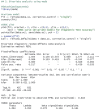Meta-analysis of diagnostic test accuracy studies with multiple thresholds for data integration
- PMID: 36228672
- PMCID: PMC10106543
- DOI: 10.4178/epih.e2022083
Meta-analysis of diagnostic test accuracy studies with multiple thresholds for data integration
Abstract
Objectives: The objective of this study is to introduce methods to use all of the information without omission when individual studies provide multiple effect sizes according to multiple cut-off values (thresholds) during diagnostic test accuracy (DTA) for data integration. For diagnostic test meta-analysis, a general performance method for synthesizing data according to one cut value in one study and a performance method for synthesizing data according to two or more cut values in one study were compared and analyzed.
Methods: As sample data for meta-analysis of DTA studies, 13 DTA studies on prostate cancer (34 effect sizes including total cut-offs) were collected. The summary statistics were calculated and the summary line was analyzed using the "meta", "mada", and "diagmeta" packagesof the R software.
Results: The summary statistics of the random effect model univariate analysis of the "meta" package with a single cut-off corresponding to the highest Youden index in a single study and those of the bivariate analysis of the "mada" package were highly similar. However, in the bivariate analysis of the "diagmeta" package including all cut-off values, the sensitivity decreased and the specificity increased as the amount of data increased.
Conclusions: Considering the heterogeneity of the summary receiver op erating characteristic curve and the use of all given cut-offs, the use of the bivariate analysis model of the "diagmeta" package is recommended. This study focused on practical methods of DTA rather than theoretical concepts for use by researchers whose fields of study are non-statistics related. By performing this study, we hope that many researchers will use R software to determine the DTA more easily, and that there will be greater interest in related research.
Keywords: Diagnostic test accuracy; Diagnostic tests; Evidence based medicine; Meta-analysis; Systematic review; Threshold.
Conflict of interest statement
The author has no conflicts of interest to declare for this study.
Figures





Similar articles
-
Diagnostic test accuracy: application and practice using R software.Epidemiol Health. 2019;41:e2019007. doi: 10.4178/epih.e2019007. Epub 2019 Mar 28. Epidemiol Health. 2019. PMID: 30999739 Free PMC article.
-
IPDmada: An R Shiny tool for analyzing and visualizing individual patient data meta-analyses of diagnostic test accuracy.Res Synth Methods. 2021 Jan;12(1):45-54. doi: 10.1002/jrsm.1444. Epub 2020 Sep 9. Res Synth Methods. 2021. PMID: 32808437 Free PMC article.
-
[Comparison of simple pooling and bivariate model used in meta-analyses of diagnostic test accuracy published in Chinese journals].Beijing Da Xue Xue Bao Yi Xue Ban. 2015 Jun 18;47(3):483-8. Beijing Da Xue Xue Bao Yi Xue Ban. 2015. PMID: 26080880 Chinese.
-
Biparametric vs multiparametric prostate magnetic resonance imaging for the detection of prostate cancer in treatment-naïve patients: a diagnostic test accuracy systematic review and meta-analysis.BJU Int. 2019 Aug;124(2):209-220. doi: 10.1111/bju.14759. Epub 2019 Apr 25. BJU Int. 2019. PMID: 30929292
-
Tutorial: statistical methods for the meta-analysis of diagnostic test accuracy studies.Clin Chem Lab Med. 2023 Jan 19;61(5):777-794. doi: 10.1515/cclm-2022-1256. Print 2023 Apr 25. Clin Chem Lab Med. 2023. PMID: 36656998 Review.
Cited by
-
Assessment of the postoperative prognosis in patients with hepatocellular carcinoma using vibration-controlled transient elastography: A systemic review and meta-analysis.Clin Mol Hepatol. 2024 Sep;30(Suppl):S186-S198. doi: 10.3350/cmh.2024.0366. Epub 2024 Aug 21. Clin Mol Hepatol. 2024. PMID: 39165160 Free PMC article.
-
Procalcitonin for the diagnosis of postoperative bacterial infection after adult cardiac surgery: a systematic review and meta-analysis.Crit Care. 2024 Feb 7;28(1):44. doi: 10.1186/s13054-024-04824-3. Crit Care. 2024. PMID: 38326921 Free PMC article.
-
Deep learning models for tendinopathy detection: a systematic review and meta-analysis of diagnostic tests.EFORT Open Rev. 2024 Oct 3;9(10):941-952. doi: 10.1530/EOR-24-0016. EFORT Open Rev. 2024. PMID: 39360789 Free PMC article.
-
Cutting-edge insights: near-infrared imaging for surgical margin assessment in head and neck tumor resection: a systematic review and meta-analysis.Quant Imaging Med Surg. 2024 Dec 5;14(12):8167-8182. doi: 10.21037/qims-24-564. Epub 2024 Nov 8. Quant Imaging Med Surg. 2024. PMID: 39698655 Free PMC article.
-
Artificial intelligence in diagnosing upper limb musculoskeletal disorders: a systematic review and meta-analysis of diagnostic tests.EFORT Open Rev. 2024 Apr 4;9(4):241-251. doi: 10.1530/EOR-23-0174. EFORT Open Rev. 2024. PMID: 38579757 Free PMC article.
References
-
- Shim SR. R meta-analysis for medical health researchers. Seoul: Hannarae Publishing; 2019. pp. 170–203. (Korean)
-
- Higgins JP, Green S. Cochrane handbook for systematic reviews of interventions. Version 5.1.0. 2011. [cited 2021 Sep 28]. Available from: https://training.cochrane.org/handbook/archive/v5.1/
-
- Shim SR, Shin IS, Bae JM. Meta-analysis of diagnostic tests accuracy using STATA software. J Health Inform Stat. 2015;40:190–199. (Korean)
Publication types
MeSH terms
LinkOut - more resources
Full Text Sources
Medical
Research Materials
Miscellaneous

